I spent much of this past Sunday exploring the South Street Seaport area.
I’ve been wandering around that neighborhood for years. My last law office–when I was practicing law for The Legal Aid Society, Criminal Appeals Bureau, before I morphed into Green-Wood’s full-time historian, was at 199 Water Street. That was four years ago. Much has changed in that neighborhood in just a few short years: 199 Water Street is now labelled “One Seaport Plaza,” several bicycle rentals seem to be prospering where none existed before, Burling Slip that I looked out over as I looked towards the East River (great view!) is now a playground, the Fulton Fish Market is gone (since 2005), and booths selling all sorts of things have been placed on the east side of South Street, under the FDR Drive. Further, a very nice mini-park has sprung up on a pier just south of the Seaport, with plantings and seating along the water. Another great access point for those who would like to enjoy the rivers that surround Manhattan–rivers that for too many years were often inaccessible.
So, you may be asking, what does all of this have to do with Green-Wood Cemetery? Well, the South Street Seaport area–where an ocean-centered economy prospered in the 19th century–offers a real who’s who of Green-Wood. It begins with Schermerhorn Row, where the South Street Seaport Museum, now run by the Museum of the City of New York, is located.

This area is a series of landfills stretching east towards the East River, each one creating new land and a new road, from Pearl to Water to Front to South Street. Schermerhorn Row, 12 warehouses, runs from Front to South Street and dates from 1812. Peter Schermerhorn (1781-1852), who developed this row of brick buildings, is interred at Green-Wood in a great Egyptian Revival granite tomb.
Across from Schermerhorn Row is this building. It is not an old building. Rather, the Laing Building,
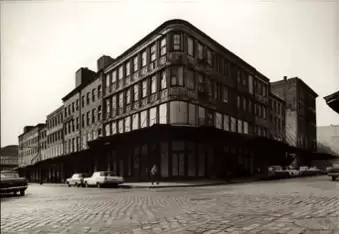
one of James Bogardus’s first cast iron buildings (Bogardus was “the father of cast iron architecture, and is interred at Green-Wood),
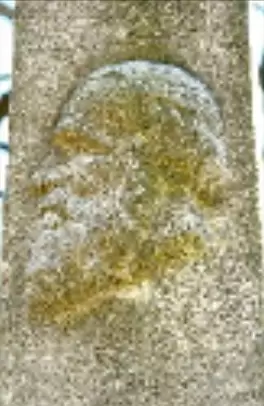
was disassembled years ago and stored under the West Side Highway. The plan: as the South Street Seaport area was redeveloped in the 1967 and thereafter, the Laing Building would be rebuilt on this corner. There was only one problem: when it came time to do so, it was discovered that so many pieces of the Laing Building had been stolen that its re-assembly was impossible. So this building, an ode to the Laing, went up.

And, just around the corner, on Water Street just north of Fulton, is this building. Notice “Edmund M. Blunt” painted across the facade. Blunt was in the chart-making business, and his two sons, Edmund and George, took over that business. They are both interred at Green-Wood.
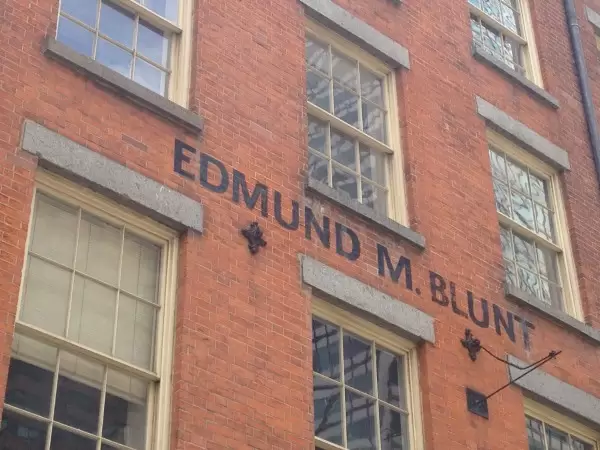
Edmund Blunt, son of Edmund M. Blunt, inherited a love of the sea from his father. Edmund, the son, ran a nautical publishing house that was located at the southeast corner of Water Street and Burling Slip. Here’s an obituary of Edmund Blunt that appeared soon after his death in 1866:
Edmund Blunt the first and oldest assistant in the survey of the coast, died on September 2, 1866, at his residence, near the city of New York in the 67th year of his age. The conspicuous services of Mr. Blunt deserve more than a mere expression of personal regret for the loss of an able associate. Since the organization of the Coast Survey he had acted an important part in earning, by the extent of his labors and the accuracy of his results, the reputation which the work has sustained for efficiency and precision. Inheriting from his father a strong inclination for hydrographic pursuits, and commencing in early boyhood the practice of his profession, his entire life may be said to have been devoted to the security and extension of our commerce by determining and describing the dangers in its path. The law of Congress which provided for the survey of the coast did not take full effect until 1832. Previous to that date the charts of our coast were based upon the early and cursory surveys of Des Barres and others, occasionally corrected by detached surveys in pursuance of special acts of Congress, or by private enterprise. Foremost in this laudable work was the father of the subject of the present notice, Edmund M. Blunt, who, in addition to the Coast Pilot, compiled and published at his suggestion in 1796, undertook hydrographic surveys and examinations. In these latter operations his sons took an active part. Before he was 18 years of age, Edmund Blunt made a survey of the Harbor of New York. In the years 1819-20 he assisted in the sounding of the Great Bahamas Bank route to the Gulf of Mexico; afterwards in the survey of Nantucket and George’s shoal. In 1824 he surveyed the seacoast in the vicinity of New York Bay; and between the years 1828 and 1830 the shores and shoals of Long Island Sound. Early in 1833 Blunt was appointed an assistant in the Coast Survey, that work, after a suspension of 15 years, having been then resumed. This appointment enabled him to bring to the performance of the duties assigned to him, in the systematic operations about to be undertaken, the skill and experience acquired during his previous career. In subsequent years, as the geodetic survey advanced, the name of Assistant Blunt became in succession identified in its records with the triangulation of Long Island Sound and of the adjacent coast; with the triangulation of Delaware Bay and River; with the measurement of a base line for verifying the primary triangulation completed previous to 1844; with various detached surveys between New York and Boston; with the triangulation of Chesapeake Bay; and with that of the valley of the Hudson between New York City and Albany. The death of Mr. Blunt was sudden and unexpected. He retained to the last day of his life the vigor and activity which had marked his early manhood. In field operations he laid the basis for the excellent work which he performed by untiring search, and by adopting in all cases the means suggested in a comprehensive review of the ground features, however extended the area might be, designated for triangulation. Concerned chiefly in the primary work, on parts of the coast presenting all the natural difficulties in the way of observing over extended lines of sight, he brought into use many of the expedients now regularly employed in similar localities. The regard for his profession, which seemed to strengthen as time drew on, was befitting in one who had largely shared from the beginning in the labors pertaining to the geodetic survey of the coast. Prompt, energetic and successful in the field, and at all times devoted to the interests and credit of the work, the example of Mr. Blunt commanded the respect, as his kind and genial disposition gained the regards of all his associated on the survey.
Edmund Blunt was in business with his brother, George William Blunt (1802-1878), who also is interred at Green-Wood. George was born in Newburyport, Massachusetts and also inherited his father’s love of the sea, leaving school at the age at the age of fourteen to work on a ship. After five years he gave up life at sea to marry and settled in New York City, where his brother Edmund ran his nautical publishing house. George worked at updating nautical charts of the Bahama Banks and New York Harbor. In 1833 he was named first assistant of the United States Coast Survey and he held that position until his death. He became the leader of the publishing house and authored many of its books and charts. He wrote Memoir of the Dangers and Ice of the North Atlantic Ocean (1845), The Way to Avoid the Center of Our Violent Gales (1868), and Pilot Laws, Harbor and Quarantine Regulations of New York (1869). The Blunt brothers chart business, which published “charts of all the navigable world,” was substantial. They also sold compasses, sextants, and nautical instruments of all descriptions. Blunt’s books and charts provided the foundation for the United States Hydrographic Office; in 1867, upon his retirement, he sold the copyrights to his Coast Pilot and Practical Navigator, as well as many of the engraved plates for his charts, to the U.S. government, which continued to print them for many years. He was on the board of New York Pilot Commissioners for many years, forwarded complaints to Washington from captains, which led to reform in the lighthouse service, organized the pilot service in New York Harbor, was a harbor commissioner, and was a trustee of the Seaman’s Retreat. He also served as commissioner of immigration, was on the committee which licensed sailors’ boardinghouses, and helped found the U.S. Lighthouse Board and the Union League Club. worked on nautical charts of the Bahama Banks and New York Harbor.
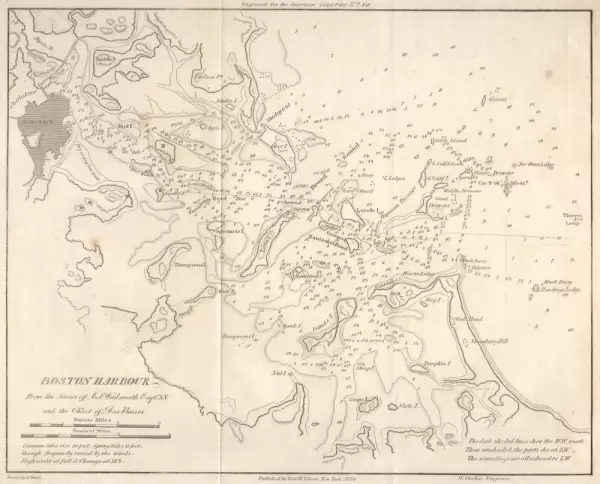
Several ships are docked at South Street Seaport, including the Ambrose Lightship. It is named for John Wolfe Ambrose (1838-1899), who also is interred at Green-Wood. Ambrose was president of the 39th Street Ferry Company, which operated between Brooklyn and Manhattan. Shortly before his death, he appeared before the United States Senate’s Committee on Commerce, petitioning for a bill to finance the widening and deepening of the shipping channel in upper New York Bay. This bill was approved and, after his death, the new channel was named in his honor. Later, also in his honor, the Sandy Hook Lightship, positioned off that nautical hazard to warn ships arriving in New York Harbor, was renamed the Ambrose Lightship. The Ambrose Lightship was taken out of service in 1967, replaced by the Ambrose Light. It was docked at Pier 16 in 1968, and has remained there ever since. It is a National Historic Landmark. An Brooklyn inlet that Ambrose filled in became known as Ambrose Park.
And, speaking of Ambrose Park, let’s digress for a moment, going back to 1894, when Buffalo Bill brought his Wild West Show to Brooklyn, and packed audiences in for months.
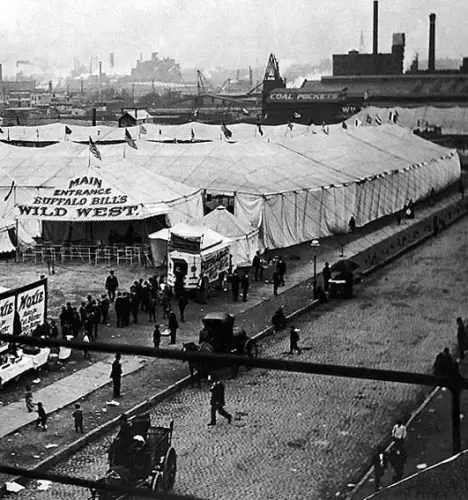
Here’s the account from the Brooklyn Daily Eagle of May 13, 1894:
“WILD WESTERN SPORTS”
Sixteen thousand persons went to Ambrose park, at Thirty-seventh Street and Third Avenue, yesterday afternoon to witness the first performance of Buffalo Bill’s Wild West show. The brilliant sunshine and balmy air quickened the appreciativeness of the audience and soothed the savage breasts of the red skinned children of the prairies who have learned to gaze complacently upon the thousands of well dressed scalp locks and regard them as representing so much cash at the box office instead of trophies to be hung in the lodge. It was a most satisfactory opening day to both the audience and the managers. The grounds on which the show is pitched are larger and more thoroughly laid out than any others which it ever has occupied. The cowboy orchestra has toughened the tympanums in the grand stand while the 450 rough riders of all nations came dashing into the areas in companies and assembled for the grand preliminary review. They included 185 Indians and 40 each of cowboys, United States cavalrymen, French, Irish and German troopers, Cossacks and Arabs.
After their various evolutions, came an exhibition of dexterous fancy shooting by Miss Annie Oakley, then a horse race between a cowboy, Cossack, Mexican, Arab and a Gaucho….
The old, old original Deadwood coach, that has been cared for like a baby and preserved in a ramshackle picturesqueness ever since the show was organized, was next brought in, with old John Nelson sitting on the roof behind the driver and popping off the redskins, who circled about in attack, till the cowboys came to the rescue and routed them…
After this Buffalo Bill made a grand entrance alone, and was cheered to the echo. He rode at full speed on his grand looking Kentucky thoroughbred, and cracked glass balls in the air with an off hand pace that made his precision the more wonderful. An imitation buffalo hunt with a herd of ten bison in the arena came next, and then, after an Indian attack on a settler’s cabin, the company entered again for the parting salute.
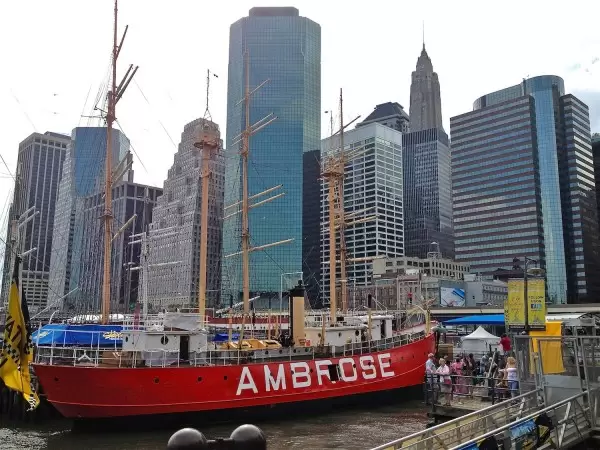
And, finally, Abiel Abbott Low (1811-1893), also a Green-wood permanent resident, was one of the leaders of clipper ship trade with China. His counting houses are now part of South Street Seaport Museum. Born in Salem, Massachusetts, he went to work as a clerk in a mercantile house trading with South America before rejoining his family in Brooklyn in 1829 to work in his father’s import business, A. A. Low and A. A. Low & Bro. Co. In 1833, he sailed for Canton, China, and began his career as a leading trader of Chinese tea and Japanese silk, eventually returning to New York to become the largest tea importer in the country. His counting house on Burling Slip (the north side of John Street in Manhattan) still stands and is a part of the South Street Seaport. During the Civil War, two of his ships were captured by Confederate cruisers and burned at sea. He was one of the financiers of the Atlantic Cable and the building of the Chesapeake & Ohio Railroad. Low served as president of the New York Chamber of Commerce (1863-1866), treasurer of the Union Defense Committee of New York, a member of the War Fund Committee of Brooklyn, and president of the committee of citizens in Brooklyn formed to support the Sanitary Commission. As president of the board of trustees of Packer Institute, a private school for girls in Brooklyn Heights, he gave bonuses to teachers and awarded scholarships to deserving Packer students anonymously. He also made substantial gifts to the Brooklyn Library and the City Hospital, and was a trustee of Green-Wood. He died in his home at 3 Pierrepont Place in Brooklyn Heights. Seth Low, the only person to serve as the mayor of the Cities of Brooklyn and New York, was his son. The Low Memorial Library at Columbia University was erected by Seth Low in his honor. Seth Low also is interred at Green-Wood.
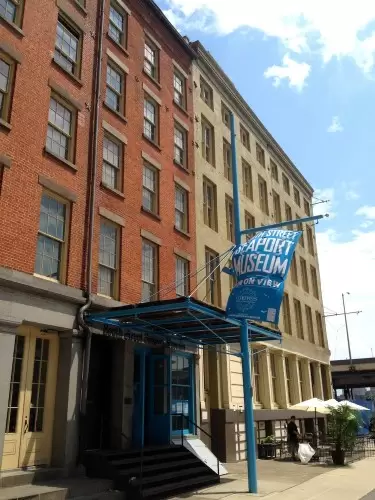
All of these ties to Green-Wood are unsurprising. These men rose to prominence in the mid-19th century with businesses related to the sea that clustered in this area. And where did the prominent men of that era choose to be interred? Green-Wood Cemetery! As Henry Raymond, co-founder of The New York Times and its first editor, said: “It is the ambition of the New Yorker to live on Fifth Avenue, to take his airings in the [Central] Park, and to sleep with his fathers in Green-Wood.”
Well said!
Great blog (as always), Jeff! Another Green-Wood connection is G. Curtis Gillespie. He was the architect of the originally Maximilian Morganthau Tobacco Warehouse at 84-85 South Street (1902 -see AIA Guide). He is, of course, also the architect of the recently purchased by Green-Wood McGovern-Weir Greenhouse. He lived in the neighborhood and is a permanent resident of Green-Wood.
Very interesting article. I always enjoy reading anything written by Jeff Richman.
Thanks!